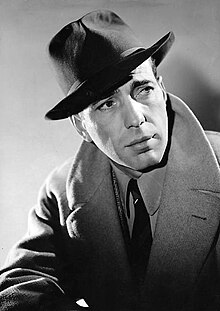
Humphrey Bogart (1899–1957)[1][2] was an American actor and producer whose 36-year career began with live stage productions in New York in 1920. He had been born into an affluent family in New York's Upper West Side,[3] the first-born child and only son of illustrator Maud Humphrey and physician Belmont DeForest Bogart.[1] The family eventually came to include his sisters Patricia and Catherine.[4] His parents believed he would excel academically, possibly matriculate at Yale University and become a surgeon.[5] They enrolled him in the private schools of Delancey, Trinity, and Phillips Academy, but Bogart was not inclined as a scholar and never completed his studies at Phillips, joining the United States Navy in 1918.[5]
On the completion of his military service, Bogart began working in theatrical productions. He was initially employed as a manager behind the scenes for the plays Experience and The Ruined Lady, before trying his talents on stage in the 1922 play Drifting. A recurring legend about Bogart is that his dialog in the 1925 play Hell's Bells was "Tennis anyone?", but Bogart denied it, saying his line was, "It's forty-love outside. Anyone care to watch?"[6] His body of stage work included more than a dozen plays, and lasted a little over a decade. He began to pursue a career in film by 1928, first appearing in the short film The Dancing Town, and then in the 1930 short film Broadway's Like That. Bogart appeared in 75 feature films, and initially believed he was on the road to stardom when he secured a 1929 contract with Fox Film. The resulting productions of A Devil with Women, Up the River, A Holy Terror, Body and Soul and Women of All Nations for Fox, as well as Bad Sister for Universal Pictures, were collectively a disappointment to him, and he returned to stage work in New York.
Bogart's break-out role was that of escaped murderer Duke Mantee whom he played in 197 performances of the 1935 Broadway theatre production of The Petrified Forest, with actor Leslie Howard in the lead. The play, and his subsequent casting in the movie version, propelled him to stardom, and secured him a movie contract with Warner Bros. He made 48 films for them, including The Maltese Falcon, To Have and Have Not, Key Largo, and Casablanca, the last of which earned Bogart his first nomination for an Academy Award for Best Actor. Bogart won the award on his second nomination, for his 1951 performance in the United Artists production The African Queen. His third Oscar nomination was for his performance in the 1954 Columbia Pictures production The Caine Mutiny. In addition to his film work, Bogart guest-starred in numerous radio and television programs, primarily reprising his film roles. He formed Santana Productions in 1948; the company's 1950 production of In a Lonely Place was chosen by the National Film Registry in 2007 for permanent preservation as "culturally, historically or aesthetically" significant. Santana Productions also created the 1951–1952 Bold Venture half-hour radio series as a vehicle for Bogart and his wife Lauren Bacall.
- ^ a b Barbour 1973, pp. 11–12.
- ^ Porter 2010, p. 500.
- ^ Fernandez, Manny (June 25, 2006). "You Must Remember This; A Sign Is Not Just a Sign (Published 2006)". The New York Times. Archived from the original on July 11, 2022. Retrieved February 15, 2021.
- ^ Porter 2010, p. 11.
- ^ a b Porter 2010, pp. 11–12, 42–43.
- ^ Porter, Darwin (2003). The Secret Life of Humphrey Bogart: The Early Years (1899–1931). Blood Moon Productions, Ltd. p. 78. ISBN 978-0-9668030-5-1. Retrieved February 2, 2022.